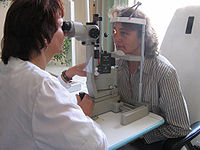
Photo from wikipedia
ABSTRACT Clinical relevance To explore optometric practices and attitudes in the management of keratoconus patients in LatinAmerica and how they are influenced by eye-care technology will help to minimise disease… Click to show full abstract
ABSTRACT Clinical relevance To explore optometric practices and attitudes in the management of keratoconus patients in LatinAmerica and how they are influenced by eye-care technology will help to minimise disease progression and their impact on patients’ quality of life in Latin America. Background Keratoconus is a progressive, bilateral and asymmetric corneal disorder that requires a multidisciplinary approach, the use of different eye assessment technology, and different management approaches; mainly contact lenses and surgery. Methods Self-reported answers to an online survey (adapted to primary eye care) distributed via a newsletter emailed by various professional organisations across 15 Latin American countries were assessed and compared with those previously reported in three European countries. Results Answers from 977 eye care practitioners (60%) with >10 years of experience (396 in Latin America and 581 in Europe) were assessed. A total of 65.9% of Latin American responders prescribed rigid corneal lenses (RCL), although more than half of the respondents (54.0%) would fit more RCL if they underwent further training in RCL fitting. A majority of Latin American practitioners (74.0%) considered that RCL fitting is more difficult in keratoconus, requiring more diagnostic lenses (4.6 ± 2.7; median 4; range 1-10) than are necessary for healthy eyes. Low availability of corneal topography was reported in Latin America (23%), although practitioners with topographers are more likely to prescribe RCL (92.3%) and detect more new patients with keratoconus per year (83.5%). A minority of respondents referred keratoconus patients to another optometrist (25.8%) or (40.4%) participated in comanagement with ophthalmologists. Conclusion This study provides initial evidence regarding keratoconus management in Latin America and suggests that actions are necessary to improve RCL training, facilitate eye-care technology accessibility and encourage comanagement between eye care practitioners to minimise disease progression and their impact on patients’ quality of life in Latin America.
Journal Title: Clinical and Experimental Optometry
Year Published: 2022
Link to full text (if available)
Share on Social Media: Sign Up to like & get
recommendations!